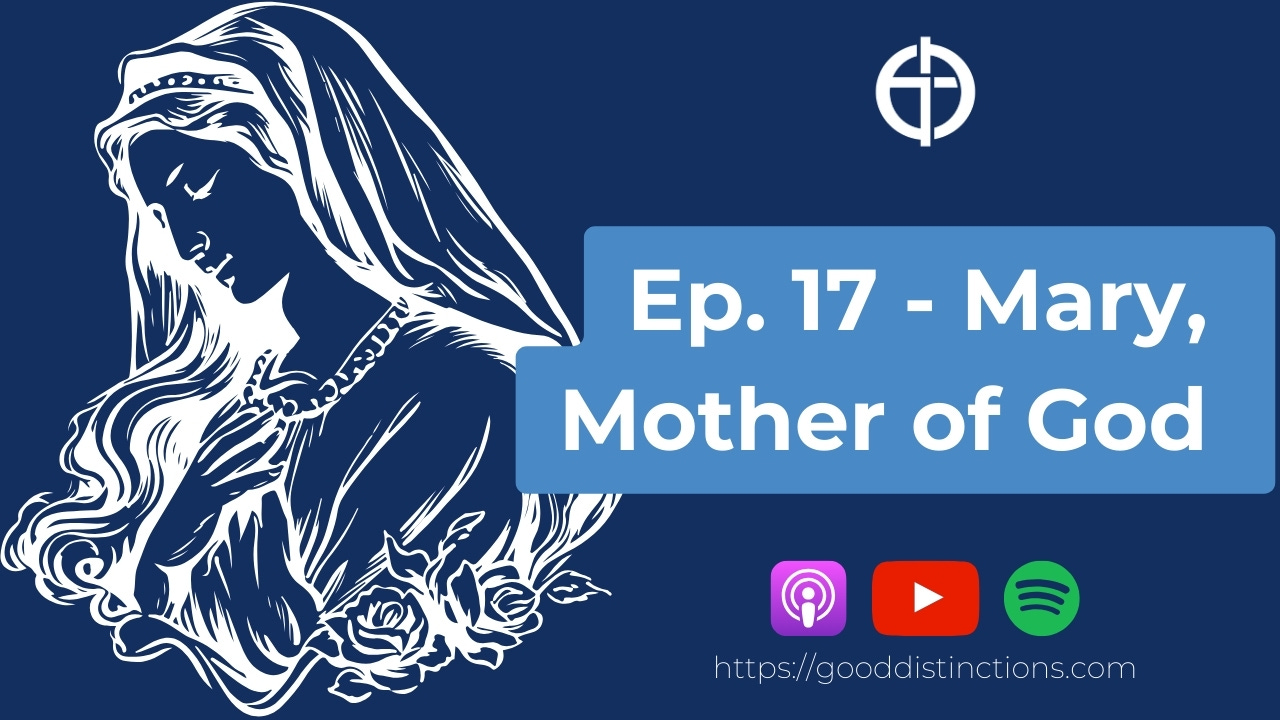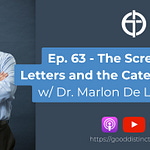(January 1 - Maria, Mater Dei)
Introduction
There are four Marian Dogmas (Marian as in related to Mary). Dogmas are those doctrines of the Church which have been especially defined by the Pope and the teaching authority of the Church. Dogmas are teachings, or doctrines, of the Church that have been bolded, underlined, and italicized, so to speak. They are proposed for our belief and faithful Catholics are not free to dissent from them.
Mary, Mother of God
The Council of Ephesus taught that Mary is truly the Mother of God, since she gave birth to the Second Person of the Trinity who became man for our sake.
In the East, this Dogma is referred to by the original Greek title of Mary: Theotokos, which means “God-bearer.” Mary of Nazareth is clearly the mother of Jesus. She bore Him in her womb, gave birth to Him, and raised Him with the help of her chaste spouse, Joseph. How can we say then that Mary is the mother of God Himself then? Because God is, in fact, a Trinity: One God in Three Persons. Is Mary the Mother of the Trinity?
No, Mary is not the Mother of the Trinity, she is only the Mother of the Second Person of the Trinity because it is only the Second Person of the Trinity who took on flesh. What the Church teaches about Mary safeguards the more central teachings concerning Jesus Christ. Mary is the greatest theologian because she always points us to the truth of her Son. She never detracts from Him and always directs us to Him.
When Jesus was conceived in the womb of the Blessed Virgin Mary, His eternal divine nature was united perfectly to the human flesh offered from Mary’s own human flesh. Jesus has a human nature and a divine nature, but we say truly that He is a Divine Person. However, mothers do not give birth to natures, but to persons. And so, we can say rightly that Mary is the Mother of God because Jesus is God and Mary is the Mother of Jesus.
Perpetual Virginity
The Church traditionally presents Mary as "virgin before, during and after giving birth", affirming, by indicating these three moments, that she never ceased to be a virgin.
The angel Gabriel revealed to Mary that she was to conceive and bear a child by the power of the Holy Spirit, despite her being a virgin. Her spiritual and physical virginity was consecrated to God and maintained for all time, what we call her perpetual virginity.
In the book of Isaiah 7:14 we hear: “Therefore the Lord himself shall give you a sign. Behold a virgin shall conceive, and bear a son, and his name shall be called Emmanuel.” Virgins don’t normally conceive a child. So, that’s a bit strange from the outset. But the original Hebrew of this passage is ambiguous. The word alma refers to a young woman, not necessarily a virgin. The Greek translation of this word is parthenos and that we get the word virgin. There is a dual fulfillment of this verse, one immediate and one ultimate. The immediate fulfillment is this - the House of David was facing imminent destruction in 732 BC and Isaiah prophesies that God will save them from destruction. The later fulfillment is made clear a couple chapters later.
In the book of Isaiah 9:6 we read: “For a CHILD IS BORN to us, and a son is given to us, and the government is upon his shoulder: and his name shall be called, Wonderful, Counsellor, God the Mighty, the Father of the world to come, the Prince of Peace.” This is clearly not an imminent fulfillment. Isaiah is saying that the Messiah to come will be God Himself in some miraculous way. We even hear where this child will be born in the book of Micah 5:2: “AND THOU, BETHLEHEM Ephrata, art a little one among the thousands of Juda: out of thee shall he come forth unto me that is to be the ruler in Israel: and his going forth is from the beginning, from the days of eternity.” Clearly, the fulfillment to come is brought to completion in Jesus Christ, born in Bethlehem to the Virgin Mary.
Thus, Mary virginally conceived Jesus without physical corruption. It was also fitting that her birth should be virginal, without physical corruption. Some of the Church Fathers hold that perhaps Jesus passed through the abdomen of the Blessed Virgin Mary as He passed through the wall into the Upper Room after His Resurrection. Some hold that she gave birth in the normal way but without any pain or damage. At any rate, the Second Vatican Council affirms this in saying, “Christ's birth did not diminish his mother's virginal integrity but sanctified it.” (Lumen Gentium 57)
Mary is a perfect model of purity, holiness, and cooperation with grace. She never detracts from Him and always directs us to Him.
Immaculate Conception
“…that the most Blessed Virgin Mary, in the first instance of her conception, by a singular grace and privilege granted by Almighty God, in view of the merits of Jesus Christ, the Saviour of the human race, was preserved free from all stain of original sin.” (Ineffabilis Deus)
God, by the grace and merits of His Son Jesus on the Cross, outside of time, preserved Mary by a singular grace at the moment of her own conception. Singular grace, though it was, the means is nonetheless the same as the means which redeems you and I: the Cross of Christ. Almighty God preserved her from all stain of the original sin of Adam and Eve. This began the reversal of the Fall of man. The early Church Fathers said, “The knot of Eve's disobedience was untied by Mary's obedience; what the virgin Eve bound through her unbelief, the Virgin Mary loosened by her faith,” and even more to the point: “death through Eve, life through Mary (Lumen Gentium, 56).”
Mary was tempted to sin just as any one of us are, but she was able to resist temptation and sin at every turn because of her heroic virtue and obedience to God in Faith. What a beautiful role model we have in our Blessed Mother. Not only was Mary the model of purity and holiness from the moment of her conception, she maintained this purity and increased in her union with God. And, remember, she never detracts from Him and always directs us to Him.
Assumption
The Virgin Mary, “having completed the course of her earthly life, was assumed body and soul into heavenly glory.” (Munificentissimus Deus)
The Dogma of the Assumption is intricately related to Mary’s special privilege of being completely without sin, her Immaculate Conception. When Jesus Christ died on the Cross, rose from the dead, and ascended into Heaven, He opened the way to Heaven. However, when we die, we will have to wait until He comes again for the resurrection of the body.
Mary, at the end of her earthly life, being completely free from sin as she was, did not see the decay of her earthly body, which is fitting for the Mother of God. By virtue of her Immaculate Conception, God chose that His mother would be taken up body and soul into Heaven to reign as Queen. Why this singular honor? We know that she never detracts from Him and always directs us to Him. So, what is the Lord doing?
While the Assumption is a special circumstance of Mary, her fate is open to be shared by all the faithful. When Christ comes again in glory, He will raise the living and the dead. This is what we call the general Resurrection and we profess it every Sunday Mass in the Creed or during the Rosary: “I look forward to the resurrection of the dead” and “I believe… in the resurrection of the body and life everlasting.”
Every human life is fashioned in the image and likeness of God. The Assumption of the Blessed Virgin Mary upholds the reality of the dignity of each and every human life. Our bodies and souls must work together to follow Jesus because our bodies and souls will hopefully be worshiping Him for eternity in Heaven, God willing. She went first where we will follow.
Co-Redemptrix and Mediatrix of All Graces
The Virgin Mary is the Mother of God, preserved immaculate from the moment of her conception, and assumed into Heaven to reign as Queen at the end of the course of her earthly life. What more could be said of the Blessed Virgin Mary? Actually, there are two interconnected doctrines of the Church which have yet to be defined with the precision of the four Marian dogmas.
Though not dogmas, these teachings on Mary are nonetheless true and show us that she never detracts from Him and always directs us to Him. Mary: Co-Redemptrix, Mediatrix of all graces, and Advocate with Jesus Christ on behalf of the human race.
The First Gospel
Before we get into the meaning of these titles of the Blessed Virgin Mary, we need to go back to the beginning. We need to go back to the Fall of man, just after Adam and Eve committed the first sin.
After the Fall of man, God turns and addresses the serpent, Satan, saying, “I will put enmity between you and the woman, and between your seed and her seed; she shall crush your head… (Gen. 3:15).” This Protoevangelium, or First Gospel, shows that God did not wish to leave the crown of creation to their ruin. He says that He shall raise up a woman, that is, a mother, who would crush the head of the serpent.
This New Eve has been identified as Mary of Nazareth, who walked alongside the Redeemer, the New Adam, Jesus Christ. With God’s grace, and by her free choice, Mary participated uniquely in God’s plan of salvation. Everything that the Church teaches to be true of Mary and proposes for belief is there as a guide and safeguard for the truths of Christ.
Co-Redemptrix
On the Cross, Jesus Christ redeemed the world. In other words, He brought back humanity from the jaws of death. He opened the way to eternal life by paying the price of the debt of Adam and Eve. He is the new Adam who makes up perfectly for the sin of the old Adam.
Likewise, the Blessed Virgin Mary is the new Eve alongside the new Adam. Mary uniquely participates with Jesus in the saving work of Calvary. Jesus is the Redeemer, and only He alone could buy back the human family from the bonds of sin. However, God willed that His Mother, as a human being, should participate in the process of redemption.
She is alongside the Redeemer and thus is called the Co-Redemptrix. The prefix “co” simply means “with.” She is the woman spoken of in the Protoevangelium that is in total enmity with Satan.
She shows us the perfect model of participating in the work of redemption. Christ accomplished the redemption perfectly upon the Cross, but the work of redemption continues until the end of time. We can unite our good works, our hopes and desires, our sufferings, and our joys to the Cross of Christ. When we do so, we offer a sacrifice of our lives in Christ and become co-redeemers.
Mediatrix of All Graces
Mary is also referred to as the Mediatrix of all graces. It first needs to be pointed out that the Second Vatican Council teaches,
“The maternal duty of Mary… flows forth from the superabundance of the merits of Christ, rests on His mediation, depends entirely on it and draws all its power from it. In no way does it impede, but rather does it foster the immediate union of the faithful with Christ (LG 60).”
Jesus is the one Mediator between God and man. Mary does not supplant this mediation, she simply participates in it in a unique way. From the moment that she consented to bring the Word of God into the world, the God-bearer continues in this mission.
The Mother of the Redeemer is given to St. John, representing the whole Church, at the foot of the Cross. Jesus says, “Woman behold thy son (cf. LG, 58).” At that moment, Mary, the New Eve, is shown as the mother of all the living. As the fathers of the Second Vatican Council say, “She is our mother in the order of grace (LG, 61),” which “began with the consent which she gave in faith at the Annunciation… and lasts until the eternal fulfillment of all the elect (LG, 62).” From the moment she said yes to God at the Annunciation, Mary began her mediating motherly role for all mankind.
Finally, the council fathers say, “Taken up to heaven she did not lay aside this salvific duty, but by her constant intercession continued to bring us the gifts of eternal salvation (LG, 62).” All of the grace of God is ordered to our eternal salvation, and Mary acquires these gifts and distributes them to all.
Mary associates with her Son in His work of redemption and mediation by the will of God the Father. It is by His plan and through her Son that Mary has any ability to do anything. The Father did not need her, but He chose her.
Mary was associated with the Redeemer in acquiring graces and so she shares with the Mediator in their distribution. As St. Bernardine of Siena said, “Every grace that is communicated to this world has a threefold course. For by excellent order, it is dispensed from God to Christ, from Christ to the Virgin, from the Virgin to us.”
Advocate
As a loving Mother, Mary cares for her children with tenderness. She brought us Jesus and continues to bring us to Jesus. As St. Teresa of Calcutta said, “No Mary, no Jesus.” She is a model for the Church and our great Advocate.
In the Sacraments:
She is with us throughout every step of our lives. She is even alongside us in the Sacraments. She never leaves her Son.
In Baptism, the stain of Eve is removed and we are given the Holy Spirit and united to the death and resurrection of Jesus. Mary, the New Eve is alongside us as she was with the Redeemer under the Cross.
In Confirmation, we receive the grace of Pentecost. Mary is present with us as she was with the Apostles at Pentecost.
The Holy Eucharist is the Body and Blood of Christ, fully human and fully divine. This is still the flesh born of Mary.
In Penance, the merits of Christ on the Cross are applied to the penitent. The mediating presence of Mary at the Cross makes her present to us in Confession.
Just as Mary did not see bodily corruption and she remained without sin, Mary advocates for us in the Sacrament of the Anointing of the Sick. She desires for us to be more in conformity with Christ and prays for us.
Jesus Christ exercised His priesthood in His humanity and divinity. Without Mary’s free consent, there would be no Incarnation, and without the Incarnation there would be no Holy Orders.
The first public miracle of Christ took place at the Wedding Feast at Cana where Christ elevated Matrimony to the level of a sacrament. Further this miracle took place as the result of Mary’s advocacy on behalf of the couple.
Only the Magisterium of the Church can declare a dogma. So, it is not up to us to decide if there ought to be a fifth Marian dogma. Regardless, these doctrines are held as part of the content of the Faith and have been celebrated in various ways in the liturgical life of the Church. Mary is the Co-Redemptrix, the Mediatrix of All Graces, and an Advocate.
Thank you for listening to Good Distinctions
Thank you for listening to Good Distinctions today on the Solemnity of Mary, Mother of God! If you have enjoyed this episode, please share it with others and then subscribe to Good Distinctions at gooddistinctions.com, on YouTube, Spotify, and Apple Podcasts. The channel cannot grow without your help. Seriously, if you do not share it, then no one else hears it! So, please take a few moments to share it on Facebook, Instagram, Twitter, LinkedIn, or anywhere else you see fit. An in-person recommendation is even better! So, tell your coworkers and friends about Good Distinctions!
I am hoping to produce one episode per week and at least four written articles or reflections per week. That is a breakneck pace, but I believe in Good Distinctions and want to continue to expand our mission to: reignite good conversations, find the best distinctions, and inspire others to do the same.
If you are in a position to support Good Distinctions financially, please become a paid subscriber at gooddistinctions.com, and if you wish to be part of Good Distinctions as a podcast guest or a contributing writer, please reach out to me at gooddistinctions@gmail.com.
Let us end with these prayers from Byzantine Catholic Morning Prayer:
“O Theotokos, my most holy Lady! Unworthy as I am, I beg you: by your holy and powerful prayers, cleanse my clouded mind and bruised heart. Free me from the memories of sins long gone by. Rescue me from every inclination to do wrong. In your goodness help me, for I am poor and lost. For you are praised by all generations, and your glorious name is honored forever.
Hail Mary, full of grace, O Virgin Theotokos, the Lord is with you. Blessed are you among women and blessed is the fruit of your womb, for you have given birth to Christ, the Savior and deliverer of our souls.
Under your protection, we hasten, O Virgin Theotokos. Do not turn away from us in our time of need, but pure and blessed Lady, save us!
You are truly deserving of glory, O Theotokos, the ever-blessed and most pure Mother of our God. More honorable than the Cherubim and beyond compare more glorious than the Seraphim, who as a Virgin gave birth to the Word of God, true Theotokos, we magnify you.
Glory to the Father and to the Son and to the Holy Spirit, now and ever and forever. Amen.”
SummaryIn this episode of Good Distinctions, host Will Wright discusses the four Marian dogmas and other teachings about the Blessed Mother. He explains that these dogmas are not man-made traditions but teachings revealed by God. The four dogmas are: Mary, Mother of God; Perpetual Virginity; Immaculate Conception; and Assumption. Will also explores the concepts of Mary as Co-Redemptrix and Mediatrix of All Graces. He emphasizes that Mary never detracts from Jesus but always directs us to Him. The episode concludes with a call to support Good Distinctions and a prayer to the Theotokos.
Chapters
00:00Introduction
01:21The Four Marian Dogmas
03:15Mary, Mother of God
06:41Perpetual Virginity
10:30Immaculate Conception
12:12Assumption
14:36Co-Redemptrix and Mediatrix of All Graces
19:11Proto-Evangelium and Mary's Role
23:02Mary's Role in the Sacraments
25:28Conclusion and Call to Action












